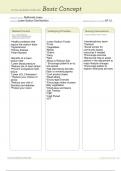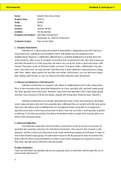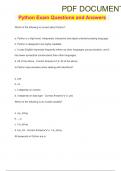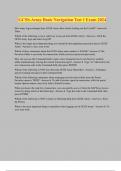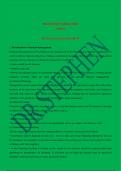Chapter 8 Motivation: Core concepts
Grit: the ability to stick to a goal and not give up even in the face of adversity
Motivation: what a person does (direction), how hard a person works (intensity), and how long a
person works (persistence).
● Energizing behavior: activating underlying needs and drives
● Directing behavior: towards goals that are important to the employee and the organization
● Sustaining behavior: provision of rewards that employees value.
● Feedback: knowledge of results of a person’s efforts. Is needed so that the processes of
energizing and directing behavior stay on track.
Maslow’s hierarchy of needs:
1. Psychological needs (e.g. hunger, sex, and other bodily needs)
2. Safety needs (protection from physical harm)
3. Social needs (belongingness and friendship)
4. Self-actualization: the drive to meet our fullest capacity (e.g., growth and feeling fulfilled as
a person)
Pro’s → simplicity and intuitive appeal; has received wide recognition, particularly among practicing
managers.
Con’s → research does not generally validate the theory. Little evidence that needs are structured or
operate in the way that is described.
McClelland’s need theory:
● Need for achievement (nAch): the drive to succeed at high levels
● Need for power (nPow): the need to influence others to do what you want
● Need for affiliation (nAff): the need for close personal relationships
Pro’s → has received more research support than other need theories.
Con’s → the application is limited because these needs are believed to be learned at a young age (it
may not be possible to increase an adult’s nAch).
Herzberg’s two-factor theory: relates to lower- and higher-order needs, and relates them to job
satisfaction. Also called the motivator-hygiene theory.
● Hygienes: things like supervision, pay, company policies, and the working conditions
● Motivators: factors that satisfy workers when they think about their job, such as
advancement, recognition, and achievement
Pro’s → Herzberg’s theory has been quite influential, known by many managers.
Con’s → not well supported. Methodology is questioned. Both factors maymotivate.
‘SMART’ Goals: for goals to motivate they need to be SMART
● Specific: a specific goal is more motivating than a ‘do your best’ goal.
● Measurable: concrete criteria for measuring progress.
● Attainable: needs to be challenging but also realistic.
● Relevant: the goal should support or be in alignment with other goals
● Time based: a specific time frame
,Management By Objectives (MBO): a performance appraisal program where leaders meet with their
direct reports and set specific performance objectives jointly
Regulatory Goal Focus (RFT): an alternative approach to understanding how individuals strive to
meet their goals. People may set different types of goals depending on their regulatory focus.
● Promotion-focused: a need for achievement, focus on advancement, and set learning goals
○ are oriented toward growth and development
○ Tend to have a learning goal orientation (LGO): they want to learn new things at
work and see themselves as adaptable.
● Prevention-focused: a tendency to aim for getting to an end because of a fear of an
undesirable alternative
○ are oriented toward the things that feel that have to do and focus on their job
responsibilities
Job Characteristics Theory (JCT): the work itself may have characteristics that have the potential to
motivate people to higher levels of performance.
● Skill variety: the extent to which people use different skills and abilities at work.
● Task identity: the task is one that people experience from beginning to end.
● Task significance: the degree to which the job is seen as having an impact on others.
● Autonomy: the employee has the freedom to plan and perform his or her own work.
● Feedback: the job provides information on how effective the employee’s work is.
→ Motivating jobs must be autonomous, provide feedback, have one of the three meaningful factors.
→ Growth need strength: refers to a person’s need to learn new things, grow, and develop from
working.
Work redesign: load jobs with more of the core characteristics that have been shown to motivate
Job enrichment: redesigning jobs so that they are more challenging to the employee and have less
repetitive work
This job loading may be:
● Horizontal: adding different tasks at the same level
○ Job rotation: involves cross-training or allowing workers to do different jobs
○ Combining tasks: creating natural work units by putting tasks together to create a
more challenging and complex work assignment
● Vertical: adding decision-making responsibility
○ Prosocial motivation: new concept of motivation that assesses the degree to which
employees behave in a way that benefits society as a whole
○ Work may be redesigned so employees have more autonomy: ability to work alone
without supervision
Job crafting: the extent to which individuals can demonstrate initiative in designing their own work.
● Task crafting is about retooling the activities included in your job
● Relational crafting is about revamping your interactions with others
● Cognitive crafting is about reframing how you view your tasks and relationships
, Equity theory: a theory that looks at how people compare their inputs to their outcomes
→ Distributive justice: perceived fairness of how rewards are distributed
● Underpayment inequity: the perception that a person’s outcomes are not fair compared to
another person’s outcomes, given their inputs
● Overpayment inequity: the perception that a person’s outcomes are greater than they
deserve compared to another person’s outcomes, given their inputs
Organizational justice: overall perception of what is fair in an organization
● Distributive justice: perceived fairness of how rewards are distributed
● Procedural justice: perception of how fair the process was in making decisions that affect
employees
● Interpersonal justice: refers to how employees are treated by their leaders, including respect
and propriety
● Informational justice: refers to the perceived fairness of the communications made by
leaders during a process
→ May result in moral outrage: severe reaction to perceived injustice
Expectancy theory:
You will be motivated to exert a high level of effort when you believes that:
● E → P = Expectancy
○ If I put effort in, I will perform well
○ “I can do this.”
● P → O = Instrumentality
○ If I perform well, I get good outcomes
○ “I will receive a reward.”
● Valences
○ I value my obtained outcomes
Self-efficacy: an individual’s belief in his or her capacity to execute the behaviors necessary to
produce specific performance levels
Pygmalion effect: perceptions of performance expectations play a significant role in improving
performance
Galatea effect: when an individual sets high expectations for himself or herself and then performs to
these expectations
Golem effect: when an individual sets low expectations for himself or herself and then performs to
these expectations
Motivation to lead (MTL): an individual differences construct that affects a leader’s or
leader-to-be’s decisions to assume leadership training, roles, and responsibilities and that affect his or
her intensity of effort at leading and persistence as a leader. Different reasons for wanting to be a
leader:
● Affective-identity MTL: the natural tendency to lead others
● Social-normative MTL: the tendency to lead because of a sense of duty or responsibility
● Noncalculative MTL: where people agree to lead without calculating the costs and benefits
of assuming leadership
Grit: the ability to stick to a goal and not give up even in the face of adversity
Motivation: what a person does (direction), how hard a person works (intensity), and how long a
person works (persistence).
● Energizing behavior: activating underlying needs and drives
● Directing behavior: towards goals that are important to the employee and the organization
● Sustaining behavior: provision of rewards that employees value.
● Feedback: knowledge of results of a person’s efforts. Is needed so that the processes of
energizing and directing behavior stay on track.
Maslow’s hierarchy of needs:
1. Psychological needs (e.g. hunger, sex, and other bodily needs)
2. Safety needs (protection from physical harm)
3. Social needs (belongingness and friendship)
4. Self-actualization: the drive to meet our fullest capacity (e.g., growth and feeling fulfilled as
a person)
Pro’s → simplicity and intuitive appeal; has received wide recognition, particularly among practicing
managers.
Con’s → research does not generally validate the theory. Little evidence that needs are structured or
operate in the way that is described.
McClelland’s need theory:
● Need for achievement (nAch): the drive to succeed at high levels
● Need for power (nPow): the need to influence others to do what you want
● Need for affiliation (nAff): the need for close personal relationships
Pro’s → has received more research support than other need theories.
Con’s → the application is limited because these needs are believed to be learned at a young age (it
may not be possible to increase an adult’s nAch).
Herzberg’s two-factor theory: relates to lower- and higher-order needs, and relates them to job
satisfaction. Also called the motivator-hygiene theory.
● Hygienes: things like supervision, pay, company policies, and the working conditions
● Motivators: factors that satisfy workers when they think about their job, such as
advancement, recognition, and achievement
Pro’s → Herzberg’s theory has been quite influential, known by many managers.
Con’s → not well supported. Methodology is questioned. Both factors maymotivate.
‘SMART’ Goals: for goals to motivate they need to be SMART
● Specific: a specific goal is more motivating than a ‘do your best’ goal.
● Measurable: concrete criteria for measuring progress.
● Attainable: needs to be challenging but also realistic.
● Relevant: the goal should support or be in alignment with other goals
● Time based: a specific time frame
,Management By Objectives (MBO): a performance appraisal program where leaders meet with their
direct reports and set specific performance objectives jointly
Regulatory Goal Focus (RFT): an alternative approach to understanding how individuals strive to
meet their goals. People may set different types of goals depending on their regulatory focus.
● Promotion-focused: a need for achievement, focus on advancement, and set learning goals
○ are oriented toward growth and development
○ Tend to have a learning goal orientation (LGO): they want to learn new things at
work and see themselves as adaptable.
● Prevention-focused: a tendency to aim for getting to an end because of a fear of an
undesirable alternative
○ are oriented toward the things that feel that have to do and focus on their job
responsibilities
Job Characteristics Theory (JCT): the work itself may have characteristics that have the potential to
motivate people to higher levels of performance.
● Skill variety: the extent to which people use different skills and abilities at work.
● Task identity: the task is one that people experience from beginning to end.
● Task significance: the degree to which the job is seen as having an impact on others.
● Autonomy: the employee has the freedom to plan and perform his or her own work.
● Feedback: the job provides information on how effective the employee’s work is.
→ Motivating jobs must be autonomous, provide feedback, have one of the three meaningful factors.
→ Growth need strength: refers to a person’s need to learn new things, grow, and develop from
working.
Work redesign: load jobs with more of the core characteristics that have been shown to motivate
Job enrichment: redesigning jobs so that they are more challenging to the employee and have less
repetitive work
This job loading may be:
● Horizontal: adding different tasks at the same level
○ Job rotation: involves cross-training or allowing workers to do different jobs
○ Combining tasks: creating natural work units by putting tasks together to create a
more challenging and complex work assignment
● Vertical: adding decision-making responsibility
○ Prosocial motivation: new concept of motivation that assesses the degree to which
employees behave in a way that benefits society as a whole
○ Work may be redesigned so employees have more autonomy: ability to work alone
without supervision
Job crafting: the extent to which individuals can demonstrate initiative in designing their own work.
● Task crafting is about retooling the activities included in your job
● Relational crafting is about revamping your interactions with others
● Cognitive crafting is about reframing how you view your tasks and relationships
, Equity theory: a theory that looks at how people compare their inputs to their outcomes
→ Distributive justice: perceived fairness of how rewards are distributed
● Underpayment inequity: the perception that a person’s outcomes are not fair compared to
another person’s outcomes, given their inputs
● Overpayment inequity: the perception that a person’s outcomes are greater than they
deserve compared to another person’s outcomes, given their inputs
Organizational justice: overall perception of what is fair in an organization
● Distributive justice: perceived fairness of how rewards are distributed
● Procedural justice: perception of how fair the process was in making decisions that affect
employees
● Interpersonal justice: refers to how employees are treated by their leaders, including respect
and propriety
● Informational justice: refers to the perceived fairness of the communications made by
leaders during a process
→ May result in moral outrage: severe reaction to perceived injustice
Expectancy theory:
You will be motivated to exert a high level of effort when you believes that:
● E → P = Expectancy
○ If I put effort in, I will perform well
○ “I can do this.”
● P → O = Instrumentality
○ If I perform well, I get good outcomes
○ “I will receive a reward.”
● Valences
○ I value my obtained outcomes
Self-efficacy: an individual’s belief in his or her capacity to execute the behaviors necessary to
produce specific performance levels
Pygmalion effect: perceptions of performance expectations play a significant role in improving
performance
Galatea effect: when an individual sets high expectations for himself or herself and then performs to
these expectations
Golem effect: when an individual sets low expectations for himself or herself and then performs to
these expectations
Motivation to lead (MTL): an individual differences construct that affects a leader’s or
leader-to-be’s decisions to assume leadership training, roles, and responsibilities and that affect his or
her intensity of effort at leading and persistence as a leader. Different reasons for wanting to be a
leader:
● Affective-identity MTL: the natural tendency to lead others
● Social-normative MTL: the tendency to lead because of a sense of duty or responsibility
● Noncalculative MTL: where people agree to lead without calculating the costs and benefits
of assuming leadership




